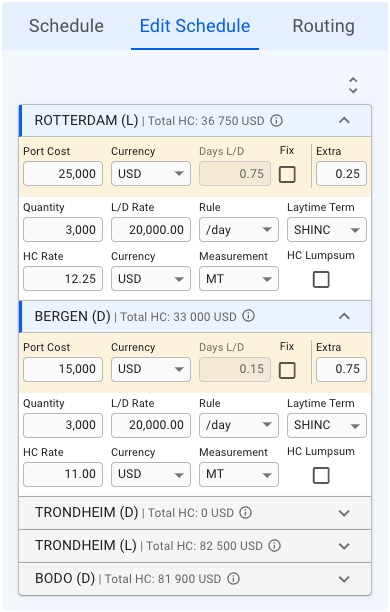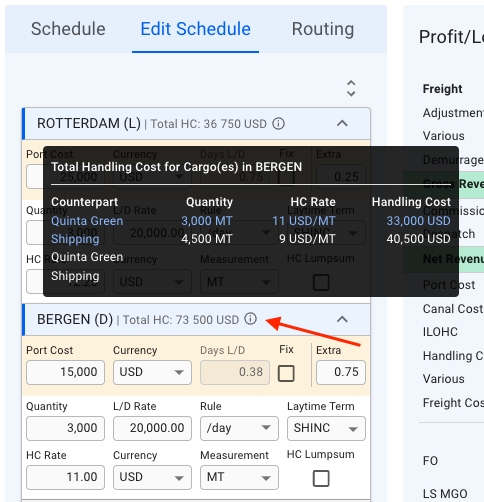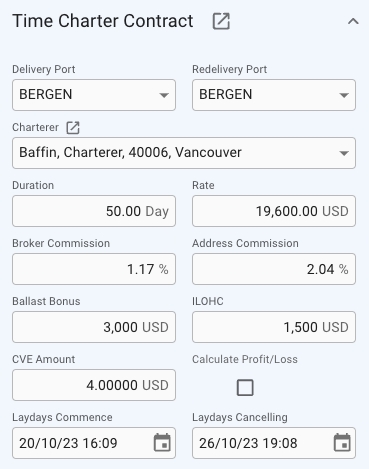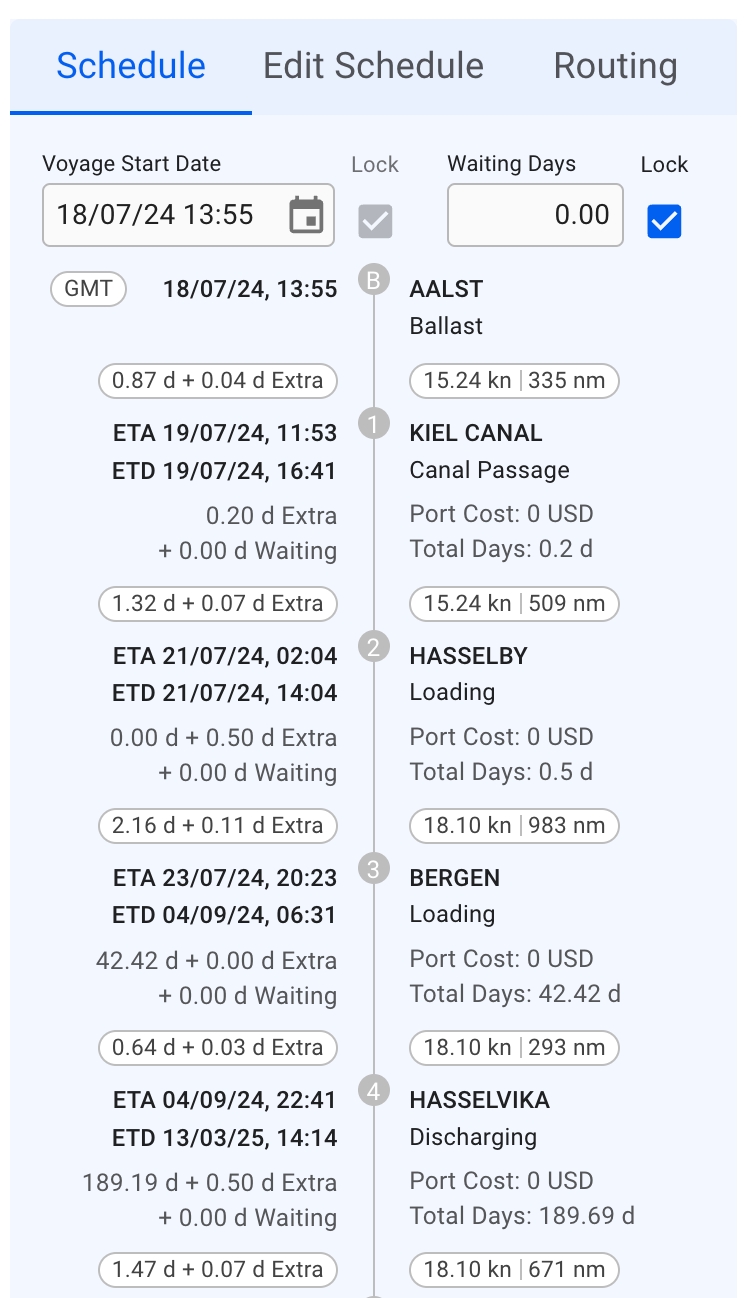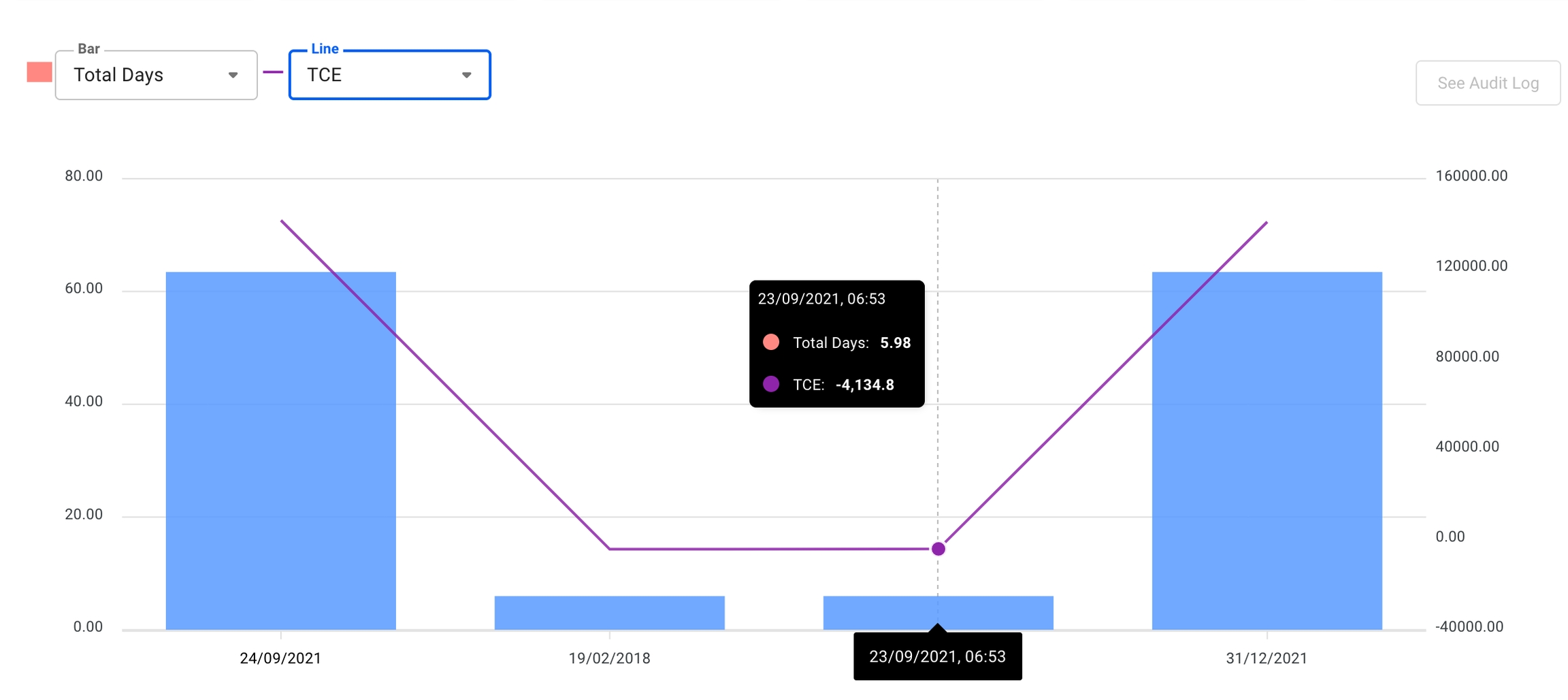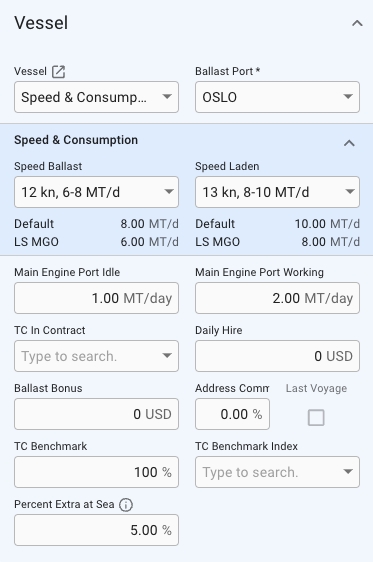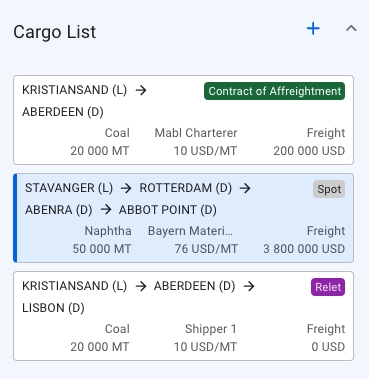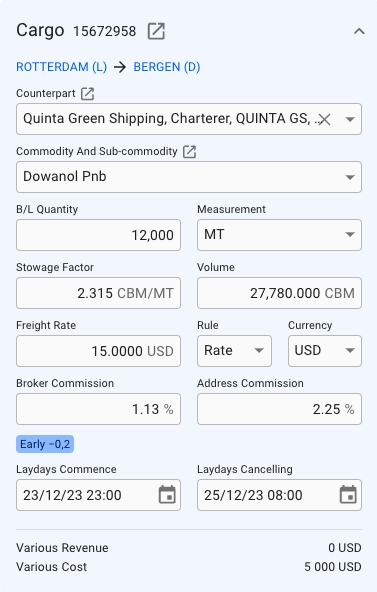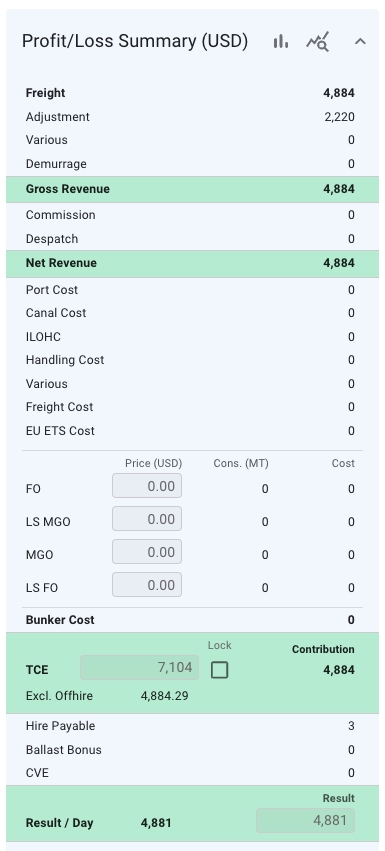
Loading...
Loading...
Loading...
Loading...
Loading...
Loading...
Loading...
Loading...
This section is visible on TC voyages.
This small section gives you the most important details of the TC Out contract, as well as the option to change them. Click the icon to open the full TC contract drawer.
This section is visible on Spot and CoA voyages.
To the left, a scrollable list of cargoes are presented as small, blue cards, showing you some select details about the cargo. This is meant to be a quick overview, to be able to differentiate between the different cargos. Clicking on a cargo will select it, and the Cargo-section to the right will update. The currently selected cargo is marked by a blue line on the left side of the card. Hovering over a cargo card will bring up the option to copy it, or open the cargo drawer. While a cargo drawer is open, you may click on any part of the card to open the cargo drawer for that cargo:
If the voyage is of type TC, a shortened list of cargo cards will be used, titled "Last Cargoes". Only the last 3 cargoes created will be displayed. To see the full list of all cargoes on the voyage, use the Cargo
Clicking the button in the top right to create a new cargo on the voyage, either from an existing CoA template, or as a brand new cargo.
The cargo section allows you to directly change some of the fields of the selected cargo (performance cargo by default) from the Voyage drawer without having to open the Cargo drawer. If you are looking for more fields however, you will need to open the up Cargo drawer (clicking the icon will open the drawer):
This page reveals the essential information of the Vessel section in the Voyage Overview tab.
Speed Ballast: Displays the speed for ballast port calls when all port calls have the same speed. If port calls have different speeds, this field will be disabled and the text will read "Multiple". Changing this value will update the speed for all ballast port calls.
Speed Laden: Displays the speed for laden port calls when all port calls have the same speed. If port calls have different speeds, this field will be disabled and the text will read "Multiple". Changing this value will update the speed for all laden port calls.
The drop-down menu will contain all vessel options for the selected passage, as well as the option to 'Add New Speed'. This new speed will not impact the vessel setup and will only apply to all Ballast/Laden port calls on the chosen voyage. This also applies to the Main Engine Port Idle and Main Engine Port Working fields. For more details, please consult the Speed and Consumption documentation.
Changing vessel in this section will change the voyage's and the connected cargoes' company and business unit to the selected vessel's.
The voyage drawer is also split up in different sections; Vessel, Cargo List, Cargo (the Performance Cargo), Schedule, Profit/Loss Summary and Speed & Consumption.
For a TC voyage, the drawer has the Time Charter Contract section instead of the Cargo section.
On the left hand-side, we have the vessel name chip, which is clickable and will forward you to the linked Vessel drawer. The number is the reference number of the voyage, and to the left we have the status. The statuses are within a dropdown menu which you can change yourself:
To the right hand-side, we have the delete button, copy button (to duplicate the selected voyage), the compare voyages button, print voyage button, the voyage functions button, the expand button, the secondary actions button and the close button. These are also called the primary actions:
In this dropdown menu, you are able to do several actions:
Swap Vessel: you are able to swap the voyage onto another vessel. Read more here.
Edit Voyage Reference: you are able to change the voyage reference number on the given voyage. Read more: Change Voyage Reference Number/Voyage Number and Voyage Starting Year.
Convert To Template: you are able to convert the voyage to a template. Here you have two different options to choose between (unless they are disabled).
Print Statement of Account: you are able to print out the SoA report of the given voyage.
Open Preliminary Voyage: Opens a new tab and brings you to the special preliminary voyage that is created when the voyage is nominated.
Mark as Optional: you are able to mark the voyage as optional, meaning you can set the statuses 'Not declared', 'Declared' or 'Forfeited' on the performance cargo of the voyage. Read more here.
Audit Log: you are able to track every action inside, and regarding, this given voyage.
Attachment: you are able to upload/download the voyage attachments.
The "Schedule" section in the Voyage drawer shows three different sub-sections; Schedule, Edit Schedule and Routing.
This is a timeline of port calls on a voyage, in which the left side displays the ETA and ETD time- and dates, as well as Days Extra and Waiting Days, with the last two also having a hover/tooltip. On the right side displays the port calls, their reason for calls, Port Costs and Total Days, with also a tooltip on the last two here.
You can create, rearrange, delete and edit port calls directly from this section (click on the picture for better view):
When hovering the mouse over a port call in the schedule, a toolbar in the upper right will appear.
To change the order of port calls, simply hover over a port call to move it into place.
Within the Schedule section, you will find a checkbox for locking the update of voyage start date and Waiting Days. This checkbox is not visible while the voyage has status Estimate or Unallocated:
This list displays a more detailed view of all the port calls in the schedule (click on the picture for better view):
The first row, in yellow highlight, you can find the Port Call's Port Cost, Currency, Days L/D, Fix checkbox and Extra (days in port).
The next two rows, you can find the Cargo Port's Quantity, L/D Rate, Rule, Laytime Term, HC Rate, (HC) Currency, (HC) Measurement and HC Lumpsum checkbox.
All of these fields are editable. The cargo highlighted in blue in the Cargo List section will also have its port calls highlighted correspondingly in the Edit Schedule section, meaning, you are viewing the selected cargo's information.
Additional Hover Information:
This tooltip displays, per Port Call, the Counterpart, Quantity, HC Rate and Handling Cost for each of it's Cargo Ports. Again, with the selected cargo from the Cargo List section highlighted in blue.
TBA.
To insert a port call before or after the port call you are editing, click the Create button and select Before or After. A window to create a new port call then pops up.
To edit a port call, click the Edit button.
To delete a port call, click the Delete button.
With this icon , you can either expand or collapse all of the port call items in the list (the list is expanded by default). You can also open and close the collapsable items, independent of each other, to view the detailed information.
All of the collapsible headers are displaying the Port Call Name, Reason for Call and Total Handling Cost (HC). Next to the last mentioned, there is an icon, which you can hover on to display additional information inside a tooltip:
When in a voyage drawer the analysis tab is available in the tab section. In this tab you will be presented with a graph to give you a visual view of the development of key values in the selected voyage.
The graph that is displayed represents the total days for the columns, and the TCE for the line. These values can be changed in the dropdown fields on the top left. The timeline shown will be from the preliminary snapshot is taken to the current date. If the voyage is closed, the last value will be the last time the voyage was changed instead of todays date.
In the Speed and Consumption section in the voyage drawer you can update the various fields for consumption for a voyage. This section can be found in the Overview-tab in the voyage drawer.
In order to expand the section to see and edit the fields, click expandon the far right of the top right summary cards.
Once the expand icon is clicked the fields will be displayed like this example:
Note that if the field for Speed Laden or Speed Ballast is changed in the vessel section it will also affect the corresponding field in this section as well, and vice versa.
The summary section displays all cost/revenue items, including fuel consumption and price, related to either cargo, voyage, or port call. This breakdown displays different figures for Voyage Charter and Time Charter estimates.
As you start to invoice various items on the voyage, the exchange rates used for calculating profit loss values will be an average of the rate used in each invoice, should those currencies differ from the voyage currency. As such, the numbers on display in the Profit/Loss summary may change slightly throughout the voyage, but should be exact once the final invoice has been issued.
When the voyage drawer is open, selecting Open Full Screenexpands the panel and shows an additional section/panel summarising the profit/loss for this voyage.
To show the analysis section, click Analysisat the top of the panel. To show an overview bar chart, click Result Chartat the top of the panel.

